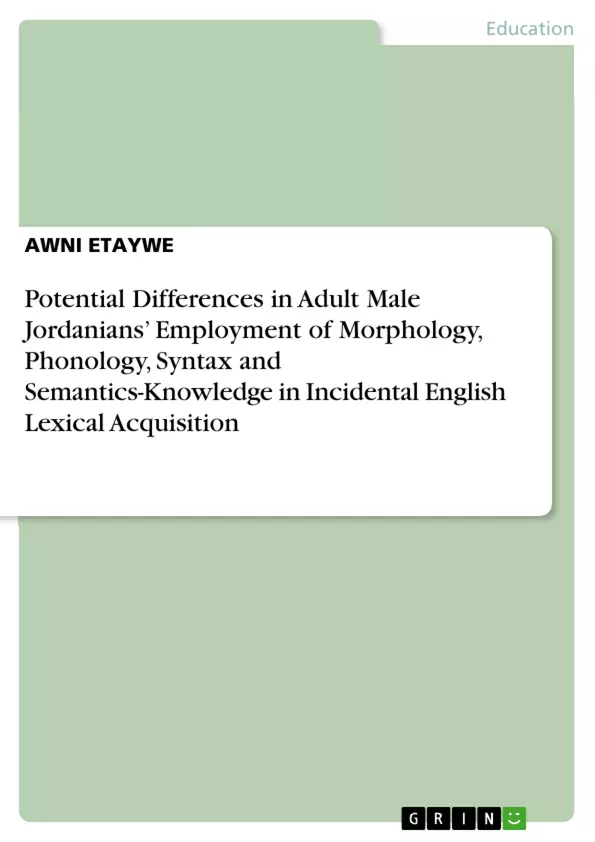This study aims at investigating the potential differences in employing different linguistic knowledge sources by adult male Jordanian English speakers. To this end, a lexical inferring test was used to instigate any previously acquired knowledge in morphology, phonology, syntax and semantics by 16 Jordanians. Data was then analyzed statistically and categorized according to the employed linguistic knowledge sources. Results showed that participants generally tended to use a single linguistic knowledge source at a time.
They relied more heavily and successfully on their previous knowledge in semantics followed by morphological analysis, whereas reliance on syntax was least used, followed by dependence on phonological relationships which was the most misleading. Differences appeared in terms of the frequency of using each linguistic knowledge source as well as the success of making use of each source.
Differences can be ascribed to variance in length of individual's previous English learning experience and time given to formal instruction on applying their knowledge to reading-based lexical learning tasks. The study highlights the importance of knowledge in linguistics as a prerequisite to support cognitive processing, to overcome limited lexical knowledge and to facilitate lexical acquisition. The study has implications for lexical studies and second language acquisition.
Inhaltsverzeichnis (Table of Contents)
- Introduction
- Research Questions
- Literature Review
- Deep lexical knowledge
- Linguistic knowledge-based processes leading into incidental lexical acquisition
- Methodology
- Data collection procedures and instrument
- Data Categorization
- Results and Discussion
- Results
- Discussion
- Conclusion
- References
- APPENDIX 1
- BIO DATA
Zielsetzung und Themenschwerpunkte (Objectives and Key Themes)
This study investigates the potential differences in how adult male Jordanian English speakers use their linguistic knowledge to infer the meanings of unfamiliar words. It explores the primary and secondary linguistic knowledge sources (LKSs) used by these individuals to process and acquire new vocabulary incidentally. The study also aims to identify the most misleading LKSs employed by Jordanian English learners.
- The role of linguistic knowledge in incidental English lexical acquisition among adult male Jordanians
- The different linguistic knowledge sources (LKSs) used, including morphology, phonology, syntax, and semantics
- The effectiveness and frequency of each LKS in supporting incidental lexical acquisition
- The potential differences in LKS utilization based on individual English learning experience and formal instruction
- The implications of the findings for lexical studies and second language acquisition
Zusammenfassung der Kapitel (Chapter Summaries)
- Introduction: The study examines the role of previously learned linguistic knowledge in incidental English lexical acquisition among adult male Jordanians, focusing on the primary and secondary LKSs employed during reading tasks.
- Research Questions: The study seeks to answer questions about the primary and secondary LKSs used by Jordanian English learners, the common combinations of LKSs, and the most misleading LKS employed.
- Literature Review: This section reviews previous research on deep lexical knowledge, the relationship between linguistic knowledge and incidental lexical acquisition, and the use of various strategies for inferring word meaning from context. It explores the importance of both breadth and depth of vocabulary knowledge for successful reading comprehension.
- Methodology: This chapter details the data collection procedures and instrument used in the study, along with the methods employed for categorizing the data.
Schlüsselwörter (Keywords)
The primary focus of this study lies in exploring the use of linguistic knowledge sources (LKSs) to support incidental English lexical acquisition, particularly within the context of reading tasks. The key themes include morphology, phonology, syntax, and semantics, as well as the effectiveness and frequency of using these LKSs for inferring word meanings. The study aims to shed light on the differences in LKS utilization based on individual learning experiences and formal instruction, ultimately offering valuable insights into the relationship between linguistic knowledge and second language acquisition.
- Citation du texte
- AWNI ETAYWE (Auteur), 2016, Potential Differences in Adult Male Jordanians’ Employment of Morphology, Phonology, Syntax and Semantics-Knowledge in Incidental English Lexical Acquisition, Munich, GRIN Verlag, https://www.grin.com/document/353469



